March 1992 - NIKHEF Amsterdam - Main Computer Room: "We have connectivity!" Marten called out. "Running the check script." Daniel responded. The two young engineers were intently looking at their screens, totally oblivious to anything around them: the noise of the air-conditioning fans, the blinking lights of communications equipment and the whining of the high-speed disk drives.
They did not pay much attention to the clutter of empty boxes they had scattered around the table while unpacking their newest 'toys'.
Marten Terpstra and Daniel Karrenberg sat in front of a small table in the main computer room of NIKHEF-H, the Dutch National Institute for High Energy Physics. The huge room was largely empty. A couple of years earlier the big 'mainframe' computer had been replaced by a much more powerful and much smaller machine. That new machine sat in the centre of the room now, just a couple of waist-high cabinets with no blinking lights at all; quite disappointing for visitor tours, but now there was ample space to unpack and set up new equipment.
"These screens are really nice and the machines feel very fast with the new processors and 32MB of memory. I really like having 2GB of disk on the file server. We are not going to run out of space soon," Marten said ethusiastically while they were waiting for the script to complete.
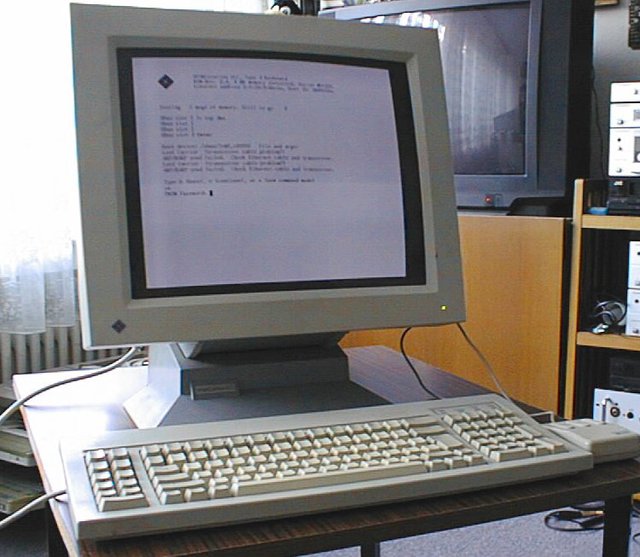
Daniel smiled: "Yes, the SUN salesman was really wondering why we were not ordering an expensive 'server' with the workstations. He just did not understand that these ELCs do work quite well as servers and they cost so much less." "Probably the same salesman who tried to sell new servers to CWI by giving Jaap Akkerhuis a SUN necktie," Marten responded and they both laughed, briefly picturing Jaap wearing a tie at work.
They had set up the two SUN 'ELC' workstations, each with a whopping 32MB of memory and with external disks of 1GB and 2GB, respectively. These machines were much too powerful to be used as a workstation for a single person. These were the first two servers of the RIPE NCC, the coordination center for the European Internet. The RIPE NCC was due to open a week later, on 2 April 1992, in offices just a few steps from the computer room. Daniel was going to lead the set up of the new center during a one year leave-of-absence from CWI, the Dutch National Institute for Mathematics and Computer Science. Marten was to fill the 'Network Engineer' position, leaving NIKHEF. When the new computers had been delivered a week early, they had immediately agreed to set them up right away in spare time from their day jobs at NIKHEF and CWI. Computers were scarce and the earlier the RIPE-related tasks could be moved to these machines the better.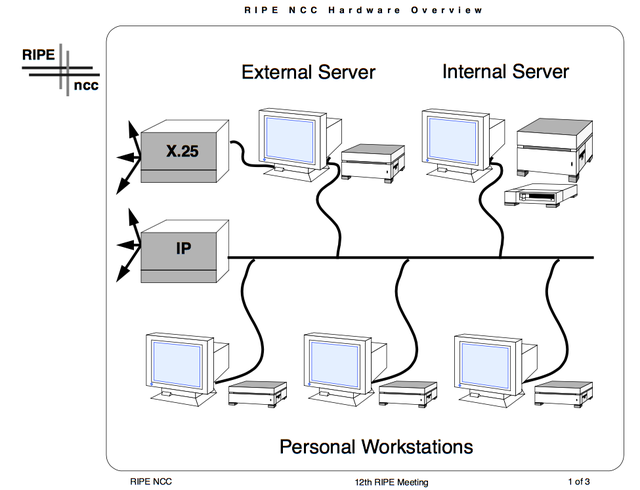
One major task for the new RIPE NCC was to maintain the 'RIPE Database', a collection of infomation that was crucial for the operation of the European part of the Internet. This database had been created and maintained by volunteers led by Daniel in the years before. The volunteers had been struggling to keep up with the increasing stream of new information and updates. Daniel was now copying that database over from 'mcsun', the main node of EUnet located at CWI.
Marten was curious: "How many objects did you copy?" Daniel ran a script. "3,365 networks, 2,242 persons and 1,360 domains," he answered after a short while. "More than twice what it was last year. It is growing fast," Marten remarked. "How come it still answers queries that fast?"
Daniel was happy to explain: "It is really simple: Just a big text file with objects separated by blank lines. The queries are fast because of a separate index using the 'dbm' library. My person object for instance is indexed under 'Daniel', 'Karrenberg' and my NIC handle 'DK58'. The index contains the byte offsets of all matching objects in the file. So in order to find 'Marten Terpstra' the server locates the offsets of all 'Marten's and all 'Terpstra's. Then it seeks to each offset it finds in both of the lists and copies up to the next blank line. That is quite fast. It is not my design either, just a personal address book program I got from Peter Collinson at Canterbury. I extended it a little for our purposes. I also added a way to query it by e-mail."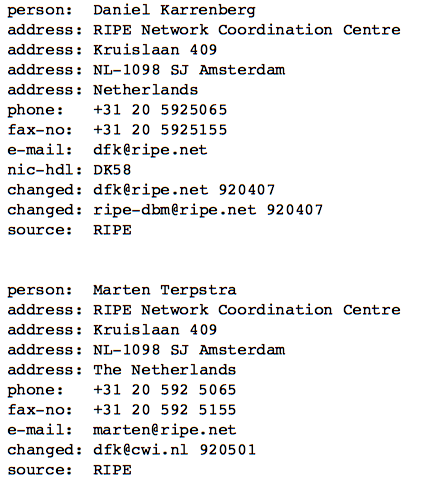
"But what if objects are updated?" Marten asked. "All your indexes will change!"
"The file size at the time of indexing is stored in the index. Then the update process just appends new objects at the end of the file without changing the index. So the server knows which objects are new and not yet indexed and checks them for each query. In case of updates to existing objects we just add the new object at the end of the file, then overwrite the first four bytes of the old object with Xs and the server will ignore those. Just like Xing out a mistake when using a typewriter. So the server program is simple and small. It does not need much memory."
Daniel was thinking ahead: "Once we are finished here, we need to find the cable to our new office and connect it up. It must end somewhere under the raised floor in the corner over there." In one corner of the room there was a cabinet of blinking modems and a beige box with a bright red stylised image of the Golden Gate bridge on the front cover. Insiders recognised it immediately as an AGS, the main product of a start-up company called Cisco Systems. In fact this box was one of the very first routers Cisco had sold in Europe. Marten was responsible for the care and feeding of it.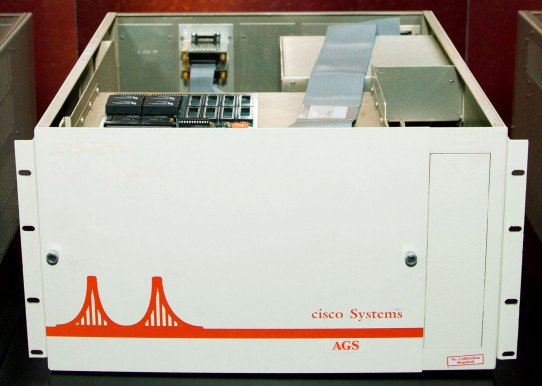
The two workstations and the AGS router were connected to a thin black RG58 coaxial cable with T-shaped barrel connectors. All devices on the same cable shared a theoretical maximum transmission capacity of 10 Mbit/s. This arrangement was informally known as "Cheapernet" because it was cheaper than the original Ethernet with its yellow, larger diameter and difficult-to-install cable.
The router was also connected to the campus network of the "Wetenschappelijk Centrum Watergraafsmeer", now "Amsterdam Science Park". Daniel Karrenberg was responsible for a couple of routers at CWI. One CWI AGS, the very first such box CISCO shipped to Europe, had direct IP (Internet Protocol) links to EUnet backbone nodes in many European countries as well as a high-speed (56kbit/s) link to the United States part of the Internet. The NIKHEF router had direct links to CERN in Geneva and to NORDUnet, the Internet in the Nordic countries. The two young engineers were at one of the hot spots of the fledgling European Internet. In fact they were sitting in the very room that would just a few years later be one of the core sites of the Amsterdam Internet Exchange, filled floor to ceiling with Internet equipment.
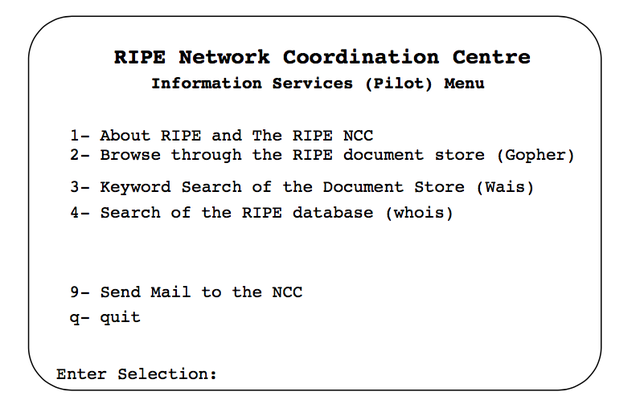
Now Daniel saw the results from the script: "Connectivity: Local WCW routers, mcsun, CERN, NORDUNET, EUnet backbone sites and U.S. sites are all responding normally. Services: whois, Gopher, WAIS, SMTP all up and running. DNS for ripe.net is responding correctly." "Time to route all ripe.net e-mail here!", Marten responded. "OK, I will ask Piet to change the mail routing on mcsun." Daniel called up 'talk' to pass on the message to Piet Beertema at CWI.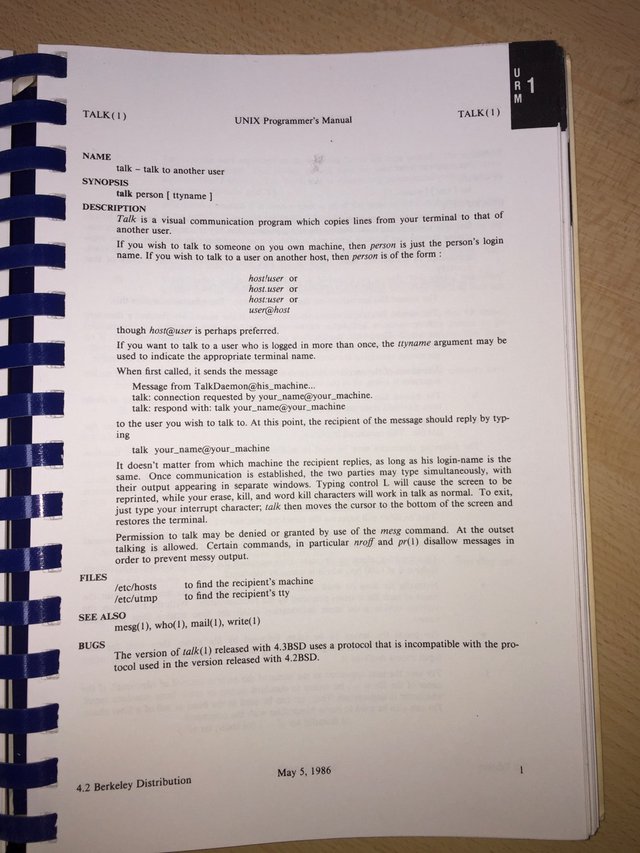
Marten reported: "Mail is coming in now. We are up and running, a week before the official start!" "Not too bad," Daniel agreed. "Let's call it a day and fetch some tables and chairs into the office tomorrow. Then we can set up the workstations."
Daniel's beeper gave off three whining sounds. He waved at Marten and left the noisy room to find a telephone. "Karrenberg," he said after dialling his beeper response number. "Anne Lord here, is this Daniel?" She was the third member of the initial RIPE NCC team calling from the UK. "Speaking! Good to hear from you. Are you all set to start on 2 May?" "Yes, all set. I can even be there in time for the RIPE Meeting at the end of next month." Karrenberg was happy about that. "That is excellent. We can use the help and it will be good for you to meet everyone in person." Daniel had one more really pressing question on his mind: "Marten and I will set up the workstations tomorrow. We decided to use synonyms or translations of the word 'ripe'. Marten decided to call his 'rijp', Dutch for ripe, and mine will be 'reif'. What name would you like for yours?" "Call it mellow," she responded.
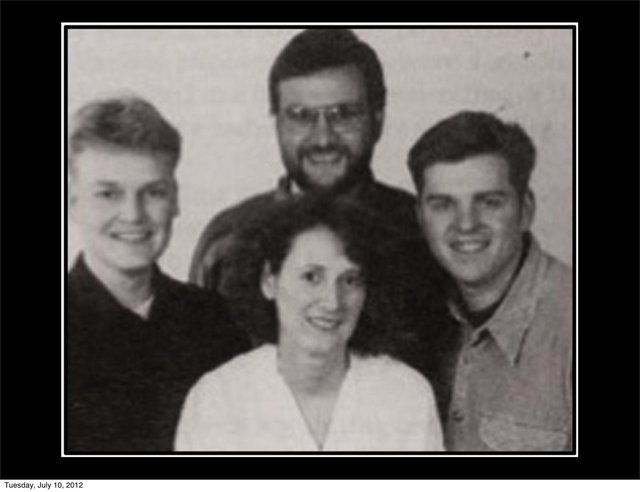
Initial RIPE NCC staff: Marten Terpstra, Daniel Karrenberg, Tony Bates (who joined a few months later) and in front Anne Lord
Sources:
- M. Terpstra: "RIPE NCC - Hardware Configuration (slides)", ripe-55, 27 April 1992
- D. Karrenberg: "RIPE NCC - Report (slides)", ripe-56, 27 April 1992
- A. Lord, D. Karrenberg, M. Terpstra: "RIPE NCC Quarterly Report - Issue 1", ripe-62, 1 June 1992
- UC Berkeley- CSRG, "UNIX User's Reference Manual", 4.3BSD Version, April 1986
- D. Karrenberg: "RIPE Database status report", ripe-52, 24 April 1992
- T. Lenggenhager: "European IP connectivity map - by domain name", ripe-32, 27 February 1991
- D. Karrenberg: "RIPE NCC Database Leaflet", ripe-58, 5 May 1992
- A. Lord: "RIPE NCC Information Leaflet", ripe-59, 5 May 1992
Revisions:
- Fixed Peter Collinson's affiliation Cambridge -> Canterbury with apologies.
- Changed 'a couple of weeks early' to 'a week early' after more study of the sources.
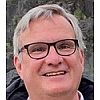
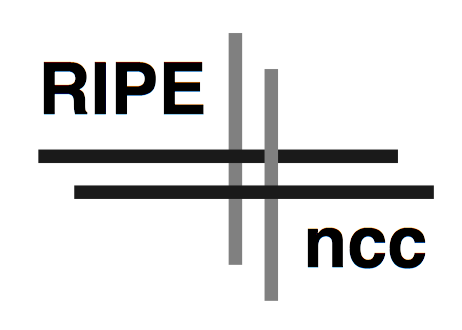

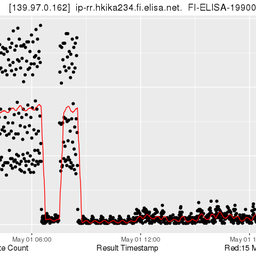
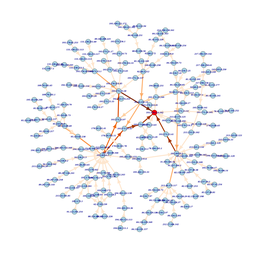
Comments 8
The comments section is closed for articles published more than a year ago. If you'd like to inform us of any issues, please contact us.
Marten Terpstra •
Have to love those early days. RIPE and the RIPE NCC have made a very significant impact on what now seems so normal and common... Wish all of you (us?) a happy 25th birthday!
Mirjam Kühne •
Hi Marten, nice to hear from you. Wish you would be here with us to celebrate!
Daniel Karrenberg •
Hey Marten, I hoped you'd give a sign of life. Great to hear from you. Drop me a private line. Mail address unchanged. Tot horens .....
Haris Hadzialic •
Dear Daniel I was in Amsterdam, at the RIPE NCC back in 1993 and 1994 to open .ba TLD with very good friend of mine Jacques Schuurman (R.I.P.). Are you that person I remember or that was someone else who worked with two of us at that time. I have lost ocnnections and would like to invite this team of 1993 for our anniversary of 30 years of .ba TLD, as this was under war time in Bosnia, so have some significant and special meanings for us. Thank you and my email is haris.hadzialic@globalgps.ba
Mohammad Wassef •
Wow , back then every thing was simple , no complications, i sincerely wish you all the best to come , you guys are the best to deal with in the whole world , never been easier for to deal with any as simple as you . thanks ripe , happy anniversary
Milad Afshari •
Very interesting story. Happy 25th anniversary, wish you guys in RipeNCC all the best.
Daniel Kalchev •
Happy 25th Anniversary! Very happy to remember these days.
Daniel Karrenberg •
Haris, I do not recall meeting you but that means very little. This was a period of many many things happening at the same time. I have helped many ccTLDs in the late 80s and early 90s. I'll get in touch privately and we will figure it out.